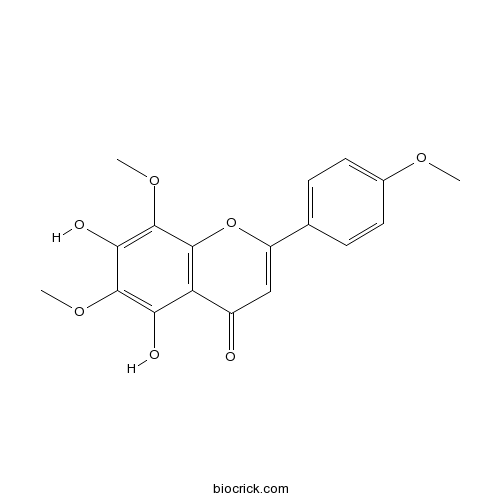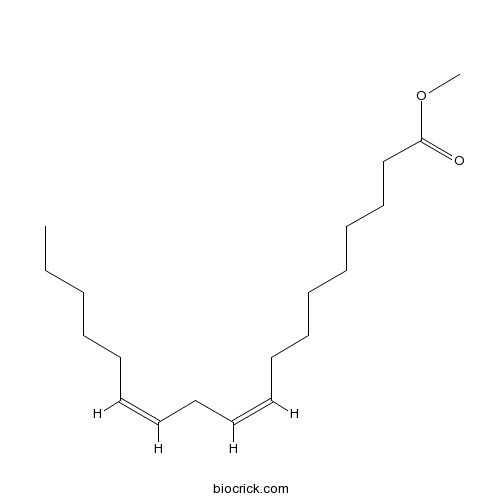Dracocephalum heterophyllum
Dracocephalum heterophyllum
1. The products in our compound library are selected from thousands of unique natural products; 2. It has the characteristics of diverse structure, diverse sources and wide coverage of activities; 3. Provide information on the activity of products from major journals, patents and research reports around the world, providing theoretical direction and research basis for further research and screening; 4. Free combination according to the type, source, target and disease of natural product; 5. The compound powder is placed in a covered tube and then discharged into a 10 x 10 cryostat; 6. Transport in ice pack or dry ice pack. Please store it at -20 °C as soon as possible after receiving the product, and use it as soon as possible after opening.
Natural products/compounds from Dracocephalum heterophyllum
- Cat.No. Product Name CAS Number COA
-
BCN6806
Nevadensin10176-66-6
Instructions

-
BCN8137
Methyl linoleate112-63-0
Instructions

-
BCN5488
Genkwanin437-64-9
Instructions

-
BCN5503
Corosolic acid4547-24-4
Instructions

Anti-hepatitis, antioxidant activities and bioactive compounds of Dracocephalum heterophyllum extracts.[Pubmed: 28597426]
Dracocephalum heterophyllum was a traditional Tibetan medicine possesses various pharmacological effects involved in anti-inflammatory, antibacterial activities. However, its anti-hepatitis, antioxidant activity and bioactive compounds have not been reported, the objective of this research work was to investigate the pharmacological activity and bioactive compounds of D. heterophyllum extracts.
Protective Effects of Dracocephalum heterophyllum in ConA-Induced Acute Hepatitis.[Pubmed: 27524863]
Dracocephalum heterophyllum (DH) is a Chinese herbal medicine used in treating hepatitis. However, the protective effects and pharmacological mechanisms of DH in hepatitis are unknown. In this study, we found that pretreatment with DH extract significantly ameliorated liver injury and suppressed the production of inflammatory cytokines, including tumor necrosis factor (TNF-α) and interferon-γ (IFN-γ) in Concanavalin A- (ConA-) induced hepatitis (CIH). DH recruited more CD11b(+) Gr1(+) myeloid-derived suppressor cells (MDSCs) to the liver and suppressed infiltration of macrophages (Kupffer cells) in the liver. The present work explores DH as an effective hepatoprotective medicine to inhibit inflammation and liver injury caused by hepatitis.
Development of HPLC Protocol and Simultaneous Quantification of Four Free Flavonoids from Dracocephalum heterophyllum Benth.[Pubmed: 26064121]
Quantification of the four flavonoids, namely, luteolin, kaempferol, diosmetin, and chrysosplenetin, has been performed for the first time in 80% ethanolic extract of Dracocephalum heterophyllum B. through HPLC coupled to UV detector after optimization of extracting solvent and chromatographic conditions. Total flavonoids quantified were 0.324 mg/mL of the extract. HPLC analysis delivered contents of the luteolin, kaempferol, diosmetin, and chrysosplenetin as 0.08%, 0.14%, 0.28%, and 0.79% of the dried extract, respectively. LOD (%) values calculated were 0.04, 0.03, 0.03, and 0.08 and LOQ (%) values were 0.08, 0.12, 0.11, and 0.28 for luteolin, kaempferol, diosmetin, and chrysosplenetin, respectively. The recovery percentages for these flavonoids were within the acceptable range of 95% to 105%. Standard deviation and %RSD were calculated for each target analytes individually in extract for determining the reproducibility and accuracy of the method. In no case the %RSD was higher than 1 taking retention time as a factor while in the case of area under the curve maximum %RSD was noted in the case of diosmetin as 2.85. From our literature review regarding the plant species under study, it appears that these flavonoids have not been quantified before and are reported for the first time in this paper.
Chemical composition and biological activity of essential oils of Dracocephalum heterophyllum and Hyssopus officinalis from Western Himalaya.[Pubmed: 25920235]
The essential oils of two representatives of the Lamiaceae, Dracocephalum heterophyllum Benth. and Hyssopus officinalis L., are described for their antifungal, antibacterial, larvicidal and inect biting deterrent activities. Additionally, the chemical compositions of the essential oils, analyzed by simultaneous GC-MS and GC-FID, and odor descriptions are given. The main components of H. officinalis oil were pinocarvone, cis-pinocamphone, and β-pinene. Citronellol was found as the main compound of D. heterophyllum essential oil. Antibacterial testing by agar dilution assay revealed greater activity of D. heterophyllum against Staphylococcus aureus compared with H. officinalis. D. heterophyllum essential oil also showed promising antifungal activity against Colletotrichum species and was more toxic to Aedes aegypti larvae in a larvicial bioassay. Both essential oils showed high activity in the biting deterrent bioassay.
Phenolic alkaloids from the aerial parts of Dracocephalum heterophyllum.[Pubmed: 22800911]
Chemical examination of aerial parts of Dracocephalum heterophyllum resulted in isolation of phenolic alkaloids, including two flavonoidal alkaloids, drahebephins A and B, one imidazole alkaloid with a phenolic substituent, drahebenine, together with 15 other known compounds. Their structures were established by extensive spectroscopic data analyses. Due to the stereogenic center in the pyrrolidin-2-one ring, the flavonoidal alkaloids are chiral, although they were isolated as racemates. The enantiomers were separated by HPLC using a chiral phase and stereochemically characterized by circular dichroism (CD) spectroscopy. The structure of compound drahebenine was established by X-ray crystallography.
Diverse communities of arbuscular mycorrhizal fungi inhabit sites with very high altitude in Tibet Plateau.[Pubmed: 21707673]
Diversity of arbuscular mycorrhizal fungi (AMF) is well studied in many ecosystems, but little is known about AMF in cold-dominated regions with very high altitude. Here, we examined AMF communities associated with two plant species in the Tibet Plateau. Roots and rhizosphere soils of Dracocephalum heterophyllum (pioneer species) and Astragalus polycladus (late-successional species) were sampled at five sites with altitude from 4500 to 4800 m a.s.l. A total of 21 AMF phylotypes were identified from roots and spores following cloning and sequencing of 18S rRNA gene, including eight new phylotypes and one new family-like clade. More AMF phylotypes colonized root samples of D. heterophyllum (5.4±0.49) than of A. polycladus (1.93±0.25). Vegetation coverage was the most important factor influencing AMF community composition in roots. Globally infrequent phylotype Glo-B2 in Glomus group B was the most dominant in roots, followed by globally frequent phylotype Glo-A2 related to Glomus fasciculatum/intraradices group. Our findings suggest that a diverse AMF flora is present in the Tibet Plateau, comprising both potentially habitat-selective and generalist fungi.
Essential oil composition of three accessions of Dracocephalum heterophyllum Benth. cultivated at Palampur, India.[Pubmed: 18629706]
Seeds of three accessions of Dracocephalum heterophyllum growing wild in high altitude locations in the cold desert regions of trans-Himalaya were collected and propagated under polyhouse conditions at IHBT Palampur to evaluate, compare their growth performance and essential oil composition. Three different chemotypes viz., citronellol-rose oxides type, citronellol type and citronellal-trans rose oxide type were identified. Samples of essential oils were distilled separately from leaves and inflorescence of all the three cultivated accessions and characterised by capillary GC and GC-MS techniques, which showed variation in the volatile constituents. In all the three accessions, citronellol was higher in the inflorescence oils as compared to leaf oils. Rose oxides, which are important high odour value cyclic monoterpene ethers were found in the essential oil samples of leaves as well as in the inflorescence of accession II, whereas these constituents were absent in the leaves of other two accessions. The essential oil from the inflorescence part of accession I was devoid of both cis and trans isomers of rose oxide, while accession III contained only one isomer of trans rose oxide. Under polyhouse conditions, seed germination was higher in accession III, whereas aerial biomass was higher in accession I. In comparison to other accessions, yield of volatile oil was higher in both leaf and inflorescence of accessions I, whereas accession II had higher oil yield from inflorescence. This is the first report of volatile oil composition of three accessions of D. heterophyllum cultivated at Palampur having potential as a new source of high valued essential oil for introduction in the perfumery industry.
Chemical composition, antimicrobial and antioxidant activities of the essential oil of Tibetan herbal medicine Dracocephalum heterophyllum Benth.[Pubmed: 17999332]
The essential oil of Tibetan medicine Dracocephalum heterophyllum Benth was obtained by hydrodistillation with a 0.7% (v/w) yield. The chemical composition of the essential oil was analyzed by gas chromatography-mass spectral (GC-MS). Eighty-three compounds, constituting about 89.83% of the total oil, were identified. The main compound in the oil were Cineole (14.89%), trans-nerolido (7.10%), 1-m-ethyl-2-(1-methylethyl)-benzene (4.42%), Germacrene-D (4.84%), Decahydro-1,1,4,7-tetramethyl-4aH-cycloprop[e]azulen-4a-ol (4.94%), p-menth-1-en-4-ol,acetate (4.34%), 4-methyl-1-(1-methylethyl)-3-cyclohexen-1-ol (4.10%). The antimicrobial activity of the oil was evaluated against nine bacterial, one yeast, and three fungi. The antimicrobial test result showed that the essential oil strongly inhibited the growth of test microorganisms studied. The maximal inhibition zones and MIC values for bacterial, yeast and fungi strain were in the range of 18-25 mm and 0.039-0.156 mg mL(-1); *20 mm, and 0.156 mg mL(-1); 8-24 mm and 0.313-2.5 mg mL(-1); respectively. The antioxidant activity of the oil was determined by the malonyldialdehyde (MDA) test, measuring the MDA concentration in mouse liver cell microsomal after induced lipid peroxidation using FeSO(4) and ascorbic acid, The inhibition of lipid peroxidation was 59.3% with a concentration of 0.5 mg mL(-1). Result presented here may suggest that the essential oil of D. heterophyllum posses antimicrobial and antioxidant properties, and therefore, they can be one of new medicinal resources for antimicrobial agent and/or used as a natural preservative ingredient in food and cosmetics and pharmaceuticals industry.


